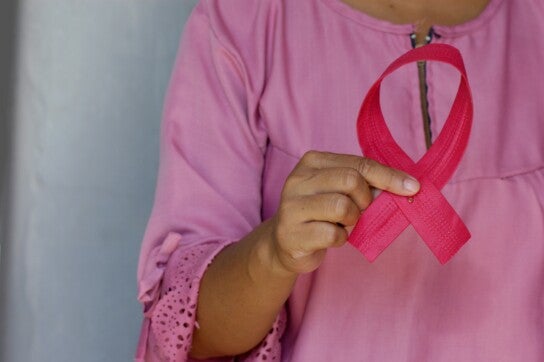Beyond Mammograms: How Hospital Foundations Are Advancing Breast Cancer Equity Through Community Benefit

Breast cancer is the most common cancer among women in the United States, aside from skin cancers. It accounts for nearly 1 in 3 of all new female cancers each year. Chances are, someone you know or love has been impacted by this disease. It’s why so many of us walk in fundraising events, pin pink ribbons to our jackets, and rally each October during Breast Cancer Awareness Month.
The message is clear: get screened. And thanks to the Affordable Care Act (ACA), screening mammograms for women ages 40–74 are covered without cost-sharing. That was a major public health victory—removing one of the biggest barriers to early detection. But there are still an opportunity and a need to do more. While the Affordable Care Act allowed for women to get coverage for an annual mammogram, there is still hidden costs.
The Hidden Costs Beyond Mammograms
When a mammogram reveals an abnormality, the next step often requires a diagnostic mammogram, ultrasound, or MRI. About 13% of women in the U.S. will develop breast cancer, but the risk is higher for the 40% of women with dense breast tissue. Dense breasts contain more fibrous and glandular tissue than fat, making cancers harder to detect on mammograms. This not only raises a woman’s risk of breast cancer by 15–20% but also increases the chance of a missed diagnosis due to “masking.”
These follow-up tests are not considered “preventive” under most insurance plans. Instead, they are billed as diagnostic procedures, which means women are often left with significant out-of-pocket costs. For many, those bills—sometimes hundreds or even thousands of dollars can be enough to delay or even forgo further testing. And that delay can mean the difference between detecting breast cancer at its earliest, most treatable stage and facing a far more serious diagnosis later. This gap doesn’t affect everyone equally. Women with high-deductible plans, those who are uninsured, and women of color—who already face higher mortality rates—are disproportionately impacted. What was intended as a health equity win has, in many ways, created a new barrier in the fight against breast cancer.
And the inequities go deeper. Younger women of color are statistically more likely to be diagnosed with aggressive breast cancers before age 40, yet routine coverage protections don’t apply to them. Many end up depending on hospital charity care, state breast cancer detection programs, or philanthropy-supported funds to access early screening and diagnostic care.
Hospitals have long invested community benefit dollars to promote mammogram access and outreach. But as long as diagnostic testing remains financially out of reach for too many women, the system falls short of its promise.
The Role Hospitals Can Play
Hospitals and health systems can help bridge this gap. While they may not be able to change insurance laws on their own, they do have powerful tools at their disposal: philanthropy, partnerships, and their community benefit mission.
- Philanthropy and Hospital Foundations: Many hospital foundations have created dedicated breast health funds to cover the cost of diagnostic imaging for women who can’t afford it. Partnering with community benefit departments, these donor-supported funds ensure that screening doesn’t stop at the first mammogram. Donors want their gifts to have tangible impact, and what’s more tangible than removing a barrier to potentially life-saving care?
- Community Partnerships: Hospitals can collaborate with mission-aligned nonprofits such as Susan G. Komen affiliates, YWCAs, and free clinics. These partnerships pool resources and expand access to diagnostic imaging for underserved women. In some states, hospitals also partner with programs like New Jersey’s Cancer Education and Early Detection Program to ensure follow-up testing is accessible.
- Mobile Outreach Programs: Mobile mammography units are an essential tool for reaching women who face geographic or transportation barriers. But too often, these programs are funded only for initial screenings. Hospitals can and should budget for follow-up imaging in mobile programs, so women aren’t left in limbo after an abnormal result.
- Policy Advocacy: Hospitals are trusted voices in health policy. By advocating for state and federal legislation that requires insurers to cover diagnostic breast imaging without cost-sharing, they can help close this inequitable loophole.
Moving From Awareness to Action
Every October, organizations rally communities around Breast Cancer Awareness Month. But awareness without action is not enough. For hospitals, the call to action is clear:
- Invest community benefit dollars in diagnostic testing, mobile programs, and equity-focused partnerships.
- Partner with nonprofits and state programs to cover gaps in coverage.
- Advocate for policy change that ensures all women can access the full continuum of breast cancer screening and diagnosis.
Example of Hospitals in Action
Here are a few examples of hospitals and hospital foundations supporting breast cancer awareness beyond mammograms.
- Penn Medicine (Pennsylvania): The Penn Medicine Breast Health Initiative provides free mammograms and Pap smears to uninsured and underinsured patients, ensuring access to essential preventive care.
- Reid Health (Ohio): The Reid Hospital Foundation provides 500 no-cost mammograms each year for women in the community who cannot afford them.
- Mount Sinai (New York): Mount Sinai’s mobile van visits all five boroughs, bringing digital 3D mammograms directly to neighborhoods and extending access to women over 40.
- UCDavis Health (California): The MobileMammo+ bus serves marginalized and hard to reach rural communities to increase access to breast cancer screenings.
This Breast Cancer Awareness Month, let’s expand the conversation. A mammogram is just the first step. Real awareness and real equity means ensuring every woman has access to the follow-up testing she needs, without fear of financial hardship. Hospitals are uniquely positioned to lead here, turning pink ribbons into concrete action. Because when it comes to breast cancer, early and thorough detection doesn’t just save money—it saves lives.
Men and Breast Cancer: An Overlooked Reality
While breast cancer is most often associated with women, men can develop it too. About 1 in 726 men will face breast cancer in their lifetime, yet awareness campaigns rarely highlight their risk. This lack of visibility means men are often diagnosed at later stages, sometimes after ignoring symptoms they didn’t realize could be cancer. By acknowledging that breast cancer affects everyone, we can begin to build a more inclusive conversation around early detection.
- About 1 in 726 men will be diagnosed with breast cancer in their lifetime (ACS).
- The ACA covers preventive mammograms for women only. Men can only access mammograms if ordered as diagnostic tests, which come with out-of-pocket costs.
- Awareness is low, stigma is high, and men often face later diagnoses and fewer support services.
Hospitals can help by making outreach materials gender-inclusive, ensuring male patients are not left behind in breast health education and care.
Want to learn how to simplify how you manage your community benefit programs? Learn how Blackbaud Grantmaking™ can help you multiply your impact and evaluate your results.


